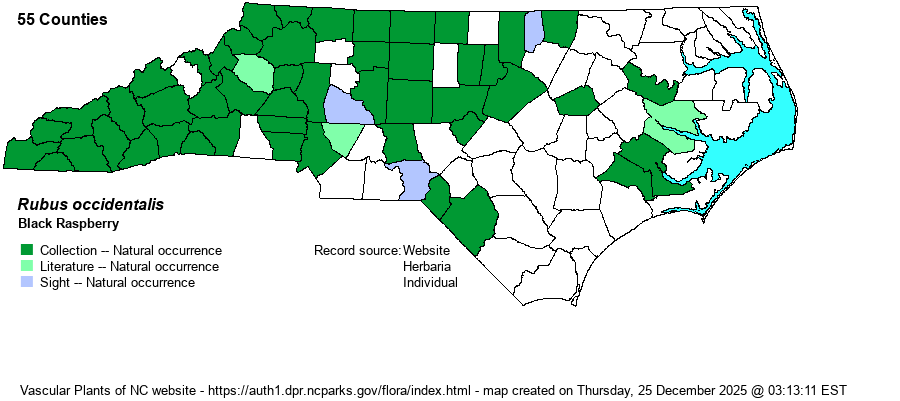| Author | L. | |
| Distribution | Throughout the Mountains and the Piedmont; widely scattered in the Coastal Plain, but likely absent in most counties within 50 miles of the coast.
This is primarily a Northern species, found across southern Canada south to SC, northern GA, and southern OK.
| |
| Abundance | Fairly common to common in the Mountains; uncommon to infrequent in the northern half of the Piedmont, but generally rare in the southern two tiers of Piedmont counties and much less common than R. argutus/pensilvanicus in these two provinces. Rare in the western Coastal Plain, and quite rare to absent farther eastward. Certainly absent in many counties in the eastern half of the Coastal Plain. | |
| Habitat | As with most blackberries, it occurs in disturbed or successional habitats, such as old fields, woodland borders, thickets, roadsides, and at times in open woods. |
| Phenology | Blooms from late April into June; fruits in June and July. | |
| Identification | This deciduous shrub is another blackberry with long and arching branches (“canes”), but only grows to 3-5 feet tall. Though it has small white flowers like Rubus idaeus/R. strigosus, this species has black berries and is considered the commercial blackberry. It is easily identified by its conspicuously white or glaucous stems, which have scattered prickles but is not bristly; and the leaflets are generally quite densely white tomentose below. These characters -– white stems/canes and strongly white leaves below -- seem to give it an exotic, non-native feel, though it is a native shrub. Most biologists should be familiar with this species in the state, even though probably more than 90% of the tall blackberry individuals they find are other species. | |
| Taxonomic Comments | None
| |
| Other Common Name(s) | Blackcap, but this is rarely used | |
| State Rank | S4 [S4S5] | |
| Global Rank | G5 | |
| State Status | | |
| US Status | | |
| USACE-agcp | | |
| USACE-emp | | |

